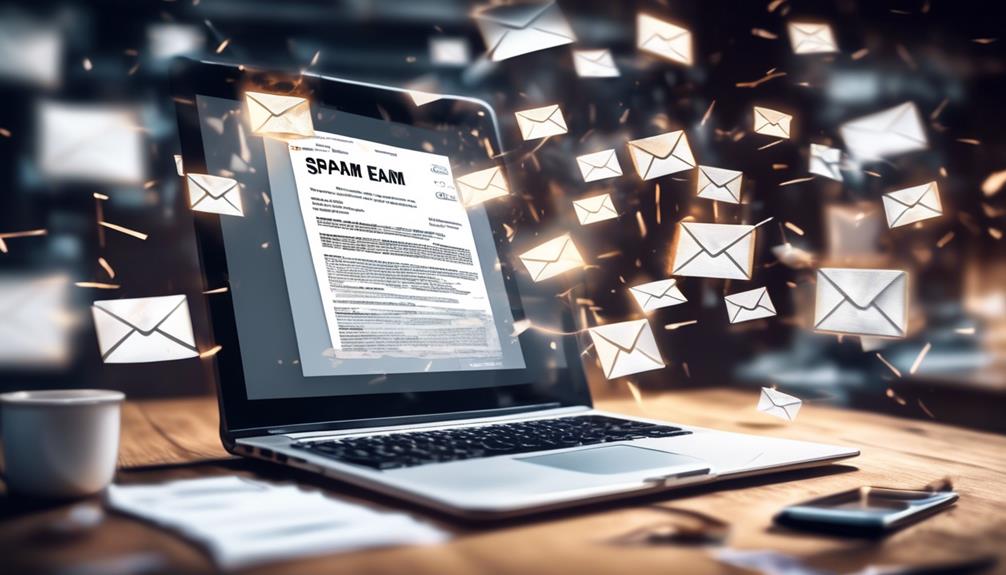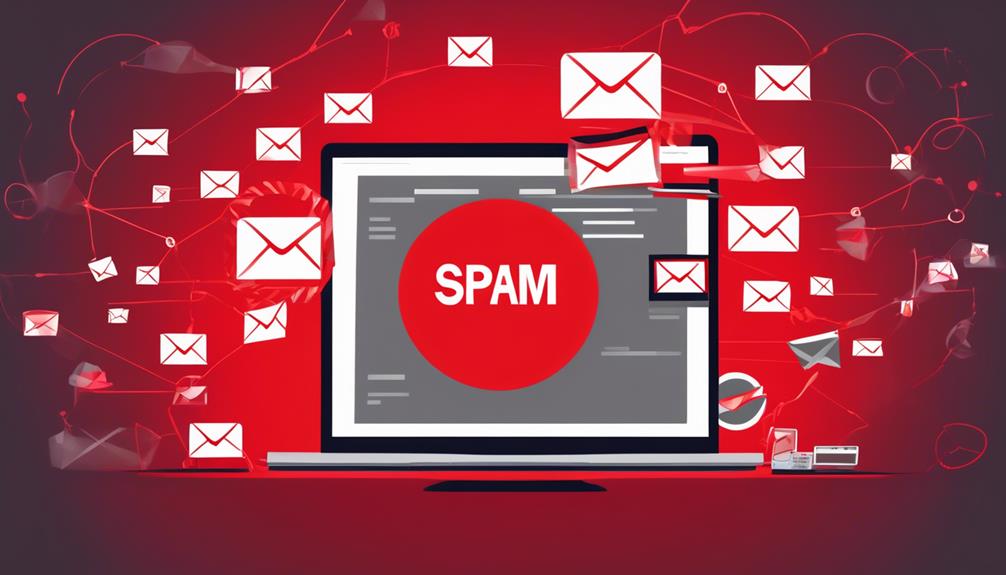We have all been there – sorting through our emails like explorers navigating a dense forest, trying to navigate through the overwhelming amount of junk mail. It feels like a never-ending downpour, with each email adding to the flood of unnecessary content.
But beyond the annoyance, there’s a deeper issue at play. Unsolicited bulk email, commonly known as spam, poses significant risks to both individuals and businesses.
So, what exactly are these risks and how can we protect ourselves from them?
Key Takeaways
- Unsolicited bulk email, or spam, makes up a significant portion of emails, with approximately 53.5% of emails in 2018 being spam.
- Spam emails often contain malicious links, attachments, or phishing attempts, posing a threat to individuals’ online security.
- The volume of spam inundating inboxes makes it difficult to identify legitimate correspondence, leading to the risk of important emails being overlooked or urgent messages being ignored.
- The impact of spam extends beyond individuals to businesses, disrupting operations, damaging reputation, and potentially leading to legal consequences.
Impact on Individuals
Unsolicited bulk email, commonly known as spam, significantly disrupts individuals’ online experience and productivity, with approximately 53.5% of emails in 2018 being spam. This poses a serious security threat, as spam often contains malicious links, attachments, or phishing attempts. The Federal Trade Commission (FTC) has warned about the risks associated with unsolicited bulk email, emphasizing the importance of maintaining a clean, up-to-date email list and seeking permission from subscribers before sending marketing communications.
The impact of spam on individuals is multifaceted. It not only inundates inboxes, making it difficult to identify legitimate correspondence, but also erodes trust in online communication. Individuals are more likely to overlook important emails or become desensitized to urgent messages due to the sheer volume of spam. Moreover, deceptive content and suspicious sender addresses in spam emails contribute to a decline in individuals’ trust and confidence in online platforms.
To mitigate these issues, it’s crucial for senders to adhere to best practices for email marketing, such as using permission-based marketing, avoiding third-party lists, and employing double opt-in methods. By respecting individuals’ preferences and privacy, the negative impact of spam on their online experience can be significantly reduced.
Impact on Businesses

Unsolicited bulk email can disrupt business operations, impacting productivity and posing legal compliance challenges.
It can also result in reputational damage, affecting customer trust and brand reputation.
These factors highlight the significant negative impact that unsolicited bulk email can have on businesses.
Business Disruption
Business disruptions can significantly impact a company’s operations, financial stability, and reputation. The table below highlights the multifaceted effects of business disruption, encompassing operational, financial, and reputational aspects.
| Type of Impact | Description | Emotional Response |
|---|---|---|
| Operational | Interruption in production, service delivery, or supply chain | Frustration, anxiety |
| Financial | Revenue loss, increased expenses, and potential long-term financial implications | Fear, uncertainty |
| Reputational | Damage to brand image, customer trust, and stakeholder confidence | Distrust, skepticism |
Unsolicited bulk email, often sent for advertising purposes, can contribute to such disruptions by overwhelming communication channels, causing system downtimes, and tarnishing brand reputation. Mitigating business disruptions requires resilient strategies, robust risk management, and proactive crisis management to ensure continuity and sustainability.
Legal Compliance
Ensuring legal compliance is essential for businesses to uphold laws, regulations, and industry standards, safeguarding against potential fines, legal actions, and reputational harm.
In the context of unsolicited bulk email, legal compliance is particularly critical. The use of email addresses for marketing purposes must adhere to laws such as the CAN-SPAM Act in the United States and the General Data Protection Regulation (GDPR) in the European Union. Non-compliance with these regulations can lead to severe penalties.
Moreover, legal compliance extends beyond just email marketing practices; it encompasses the entire process of collecting, storing, and using email addresses.
Businesses must continuously monitor and adapt to evolving legal requirements to ensure that their email practices remain compliant, thereby mitigating the risk of legal repercussions and maintaining a positive business reputation.
Reputational Damage
With legal compliance established, the potential impact of reputational damage on businesses becomes a critical consideration in the context of unsolicited bulk email.
- Reputational Damage:
- Loss of Trust and Credibility
- Decreased customer loyalty
- Negative impact on brand image and reputation
- Financial and Legal Repercussions:
- Lawsuits, fines, and loss of investment
- Difficulty in attracting and retaining top talent
The consequences of reputational damage due to unsolicited bulk email can be severe, including decreased sales, damaged partnerships, and legal implications. Proactively managing a positive reputation through ethical practices and transparent communication is essential for mitigating the impact of commercial email on a company’s image and credibility.
Recognizing Unsolicited Bulk Email

When it comes to recognizing unsolicited bulk email, it’s crucial to identify the tell-tale signs of spam emails.
Managing unwanted communications involves implementing strict filtering mechanisms and being vigilant about suspicious senders and generic greetings.
Identifying Spam Emails
Identifying spam emails involves recognizing unsolicited and deceptive content, being cautious of suspicious senders and email addresses, and noting signs such as poor grammar or generic greetings.
When identifying spam emails, it’s important to:
- Check for unsolicited and deceptive content
- Look for offers that seem too good to be true
- Be cautious of emails requesting personal or financial information
- Be mindful of suspicious senders and email addresses
- Scrutinize email addresses that appear slightly altered or unfamiliar
- Avoid clicking on any links or downloading attachments from unknown senders
Managing Unwanted Communications
Recognizing unsolicited bulk email entails understanding the history and prevalence of spam, as well as implementing effective strategies to avoid being flagged as unsolicited email. Since Gary Thuerk sent the first spam email in 1978, unsolicited bulk email has grown to account for approximately 53.5% of emails in 2018.
To manage unwanted communications, never buy mailing lists and use permission-based marketing. Activate your list, practice good mailing list hygiene, and keep it clean and updated. Ensure explicit permission to send bulk emails, avoiding assumptions and third-party lists. Implement double opt-in for added security.
Recognizing spam involves identifying unsolicited, deceptive, or suspicious content from unfamiliar senders. By following these strategies and recognizing the signs, you can effectively manage unwanted communications and avoid being flagged as unsolicited bulk email.
Risks of Unsolicited Bulk Email

The risks associated with unsolicited bulk email, commonly known as spam, are significant and multifaceted, impacting both individuals and organizations. These risks include:
- Security Risks
- Unsolicited bulk emails often contain malicious links or attachments, leading to the risk of malware, phishing attacks, and other cybersecurity threats.
- Exposure to fraudulent schemes and scams, resulting in financial losses and compromised personal information.
- Operational and Reputational Risks
- Inundation of spam emails can overwhelm email servers and networks, leading to decreased productivity and potential disruptions in communication.
- Organizations risk tarnishing their reputation by being associated with spam, potentially leading to loss of trust and credibility among customers and stakeholders.
The risks associated with unsolicited bulk email have evolved since the first spam email in the late 1970s. With the increasing sophistication of spammers and their tactics, the impact of spam has become more pervasive and damaging.
It’s crucial for individuals and organizations to implement robust measures to mitigate these risks, including advanced email filtering, employee training on identifying spam, and adherence to best practices for email marketing.
Legal Implications

Understanding the legal implications of unsolicited bulk email requires thorough knowledge of anti-spam laws and regulations, as well as a proactive approach to compliance. To comprehend the complexities of these legal implications, it is essential to consider various aspects, as outlined in the table below.
| Legal Implications of Unsolicited Bulk Email | Description | Importance |
|---|---|---|
| Potential Violations of Anti-Spam Laws and Regulations | Understanding laws governing unsolicited commercial emails is crucial to avoid legal penalties. | Compliance with anti-spam laws is essential to prevent fines and legal actions. |
| Data Protection and Privacy Laws | Adhering to data protection laws is vital to protect recipients’ privacy and personal information. | Non-compliance can lead to legal repercussions and damage to the sender’s reputation. |
| Intellectual Property Rights Infringement | Avoiding the unauthorized use of trademarks and copyrighted material in bulk emails is necessary to prevent legal disputes. | Infringing on intellectual property rights can result in legal actions and financial liabilities. |
Managing legal implications related to unsolicited bulk email involves staying informed about evolving legislation, seeking legal advice, and ensuring compliance with anti-spam laws and regulations to mitigate risks effectively.
Mitigating Unsolicited Bulk Email

We can mitigate unsolicited bulk email through effective email filtering techniques, sender authentication methods, and user education strategies.
By implementing robust email filtering techniques, we can identify and block unsolicited bulk emails before they reach recipients’ inboxes.
Sender authentication methods, such as SPF, DKIM, and DMARC, can help verify the legitimacy of the sender, reducing the likelihood of unsolicited bulk email.
Additionally, educating users about recognizing and reporting unsolicited bulk email can contribute to mitigating its impact.
Email Filtering Techniques
Using advanced email filtering techniques is essential for mitigating the impact of Unsolicited Bulk Email (UBE) on both personal and business communications. When it comes to email filtering, there are several approaches to consider:
- Permission-based Marketing: Obtaining explicit consent from recipients before sending promotional emails helps ensure that messages are well-received. Utilizing double opt-in methods, where subscribers confirm their email addresses, can further enhance the legitimacy of communications.
- Implementing anti-spam software or email filters is also crucial in protecting against spam. These tools can identify and divert suspicious emails, safeguarding users from potential threats.
- Recognizing spam involves a discerning eye for deceptive content, suspicious senders, and poor grammar in emails. ESET’s multilayered technology offers comprehensive protection against spam, bolstering business security.
Sender Authentication Methods
Implementing sender authentication methods, such as SPF, DKIM, and DMARC, is crucial for verifying the legitimacy of email senders and reducing the impact of unsolicited bulk email.
SPF allows domains to specify which IP addresses are authorized to send emails on their behalf, preventing email spoofing.
DKIM adds a digital signature to emails, enabling recipients to verify the sender’s authenticity and message integrity.
DMARC builds upon SPF and DKIM, providing a policy framework for email authentication and reducing the risk of domain-based impersonation.
By implementing these authentication methods, the likelihood of emails being flagged as spam can be significantly reduced, leading to enhanced email deliverability.
It’s important for organizations to adopt these sender authentication methods to protect their reputation and ensure the trustworthiness of their email communications.
User Education Strategies
Educating users about identifying and mitigating unsolicited bulk email is essential for maintaining email security and integrity. To achieve this, we can employ the following strategies:
- Training Programs: Implement educational programs to train users on recognizing and handling unsolicited bulk email. This can include examples of common spam tactics and how to verify the legitimacy of emails.
- Interactive Workshops: Conduct interactive workshops where users can actively engage in identifying and responding to unsolicited bulk email. This can help reinforce learning and build practical skills in email security.
Anti-Spam Measures

To combat unsolicited bulk email, it’s essential to employ effective anti-spam measures. One crucial strategy is to avoid being flagged as unsolicited email by refraining from purchasing mailing lists and instead using permission-based marketing with a double opt-in approach. This ensures that consent is obtained from subscribers before sending bulk emails, thus adhering to best practices and avoiding the use of third-party lists.
It’s also important to recognize spam by identifying deceptive, unsolicited, or too-good-to-be-true messages, as well as being cautious of suspicious email addresses and generic greetings.
Protecting oneself from spam involves avoiding indiscriminate sharing of email addresses and utilizing anti-spam software or filters. Additionally, implementing email authentication protocols such as SPF, DKIM, and DMARC is crucial to ensure the legitimacy of bulk emails and prevent them from being marked as spam.
Email Filtering Solutions

When it comes to email filtering solutions, it’s essential to consider the various spam detection methods and filtering software options available.
Understanding the different techniques used, such as content analysis and machine learning algorithms, can help organizations make informed decisions about their email security measures.
Spam Detection Methods
Spam detection methods, such as content filtering, IP reputation analysis, machine learning, and Bayesian filtering, are essential for identifying and blocking unsolicited bulk emails to safeguard recipients’ inboxes. These techniques utilize sophisticated algorithms to analyze email content, sender reputation, and user behavior to differentiate between spam and legitimate emails.
Some common spam detection techniques include:
- Content filtering
- Analyzing email content for spam indicators such as specific keywords, excessive use of capital letters, or misleading subject lines.
- Utilizing regular expressions and keyword matching to flag potential spam emails.
- IP reputation analysis
- Assessing the reputation of the sender’s IP address to determine the likelihood of the email being spam.
- Using blacklists and whitelists to categorize IP addresses based on their trustworthiness.
Implementing a combination of these spam detection methods can significantly reduce the influx of unwanted and potentially harmful emails.
Filtering Software Options
Filtering software options encompass a range of tools and technologies designed to effectively manage and mitigate the impact of unsolicited bulk email, commonly known as spam. These solutions offer features such as content filtering, blacklisting, whitelisting, and advanced algorithms to identify and block spam. They can be deployed at the server level or integrated into email clients, providing flexibility in implementation.
Some options also offer reporting and analysis tools to monitor email traffic and identify potential threats. Choosing the right filtering software involves considering factors such as effectiveness, ease of use, compatibility, and scalability to meet specific email filtering needs.
It’s important to assess the capabilities of filtering software options to ensure they align with the organization’s requirements for managing spam effectively.
Reporting Unsolicited Bulk Email

In cases of unsolicited bulk email, reporting the offending messages to the appropriate authorities or email service providers is essential for combating the issue effectively. When reporting unsolicited bulk email, consider the following:
- Reporting to Authorities
- Contact the Federal Trade Commission (FTC) in the United States or the appropriate regulatory body in your country to report the unsolicited emails.
- Provide detailed information about the unsolicited emails, including the sender’s email address, the content of the email, and any relevant details.
- Reporting to Email Service Providers
- Forward the unsolicited emails to the abuse or support department of your email service provider.
- Include the full email headers, which can be used to trace the origin of the email and identify potential sources of the spam.
Protecting Personal Information

To safeguard personal information from unsolicited bulk email, individuals and businesses should implement proactive measures to mitigate the risk of unauthorized access and misuse.
Firstly, it’s crucial to use permission-based marketing and a double opt-in approach to ensure that recipients have explicitly agreed to receive emails. This not only helps avoid being flagged as unsolicited email but also ensures legal compliance. Seeking permission from subscribers before sending email campaigns is essential for sending bulk emails legally and ethically.
Additionally, implementing anti-spam software or email filters can provide an added layer of protection against unsolicited bulk email. These tools can help in identifying and blocking spam emails, reducing the risk of unauthorized access to personal information.
Furthermore, it’s important to be cautious when sharing email addresses. Avoid posting them on public websites or indiscriminately sharing them to minimize the risk of receiving spam.
Recognizing the characteristics of spam, such as suspicious email addresses, deceptive content, and poor grammar, can also aid in protecting personal information from unsolicited bulk email.
Educating Email Users

Educating email users on the risks and best practices of unsolicited bulk email is essential for ensuring the protection of personal information. It’s crucial to provide users with the knowledge and tools to identify and handle unsolicited bulk emails effectively.
Here are the key points to consider:
- Understanding Risks and Best Practices
- Educating users about the potential risks associated with unsolicited bulk email, such as phishing attacks, malware distribution, and identity theft.
- Providing clear guidelines on best practices for handling unsolicited bulk email, including refraining from clicking on suspicious links and avoiding sharing personal information.
Industry Best Practices

Industry’s best practices recommend avoiding the purchase of mailing lists and instead utilizing permission-based marketing and double opt-in approaches. This approach ensures that recipients have expressly consented to receiving communications, leading to higher engagement and conversion rates.
Additionally, maintaining a clean and accurate email list is crucial. Regularly checking for invalid addresses and providing clear source information for the list helps uphold industry best practices. It’s also essential to obtain explicit permission from subscribers before sending email campaigns and refrain from assuming permission during list acquisition and management.
When it comes to sending bulk emails, platforms like SendPulse offer free services to manage mailing lists and send bulk emails. By registering, adding a mailing list, describing its source, and adhering to best practices, one can effectively send bulk emails without resorting to questionable tactics.
Recognizing spam is equally vital, requiring vigilance against unsolicited and deceptive content, unfamiliar senders, suspicious email addresses, and linguistic errors. By adhering to industry best practices, businesses can build trustworthy relationships with their audience while maintaining ethical standards in their email marketing efforts.
Technology Solutions

Utilizing advanced technology solutions, businesses can effectively prevent their emails from being flagged as unsolicited by employing permission-based marketing and maintaining good mailing list hygiene. To achieve this, companies should consider the following strategies and tools:
Permission-Based Marketing:
- Obtain explicit subscriber consent for sending bulk emails.
- Implement best practices such as double opt-in confirmation to ensure the validity of subscribers.
Mailing List Hygiene:
- Use platforms like SendPulse, which offer free bulk email sending after activating and adding a mailing list.
- Manage marketing emails to avoid suspicious senders and spam-like content by practicing proper email list hygiene and permission-based marketing.
Technology solutions focus on combating spam by recognizing its deceptive nature and offering protection measures such as anti-spam software, email filters, and email security settings updates.
Global Efforts to Combat Spam

Global organizations frequently collaborate to establish legislation and employ various technologies and methods to combat spam. International cooperation and legislative efforts have led to the creation of anti-spam laws and regulations through organizations such as the European Union’s General Data Protection Regulation (GDPR) and the United States’ CAN-SPAM Act. Additionally, international agreements like the London Action Plan facilitate cross-border cooperation in enforcing anti-spam laws.
Technological solutions play a crucial role in combating spam, with the use of content filtering, blacklists, and sender authentication techniques. Organizations like Spamhaus track and combat spam on a global scale, contributing to the mitigation of spam and related cyber threats.
Education also forms a key part of global efforts, with initiatives aimed at raising awareness among users about identifying and reporting spam, as well as promoting responsible email marketing practices.
Furthermore, international collaboration between governments, internet service providers, and technology companies is essential in the ongoing battle against spam. These collective efforts demonstrate a multifaceted approach to combat spam that spans across legal, technological, and educational domains.
Frequently Asked Questions
What Is an Unsolicited Bulk Email Called?
We call an unsolicited bulk email ‘spam.’ It’s sent in large quantities without the recipient’s consent, often for advertising purposes.
ISPs may block persistent senders of spam to protect their customers from security threats, as it can spread viruses and launch phishing attacks.
Botnets, networks of compromised computers, are often used to send spam. This poses a serious security threat.
Is It Illegal to Send Unsolicited Emails?
Sending unsolicited emails is illegal in many countries, including the US and the EU. It violates anti-spam laws like the CAN-SPAM Act and the GDPR. Penalties for non-compliance can be severe, including hefty fines and legal action.
It’s crucial to obtain permission from recipients before sending bulk emails, adhere to best practices, and provide opt-out options to ensure compliance with the law.
Is Spamming an Act of Sending Unsolicited Bulk Emails?
Yes, spamming is the act of sending unsolicited bulk emails. It involves mass distribution of emails without recipient consent, often for commercial purposes.
Spamming violates email marketing regulations and can damage sender reputation. To combat spam, it’s crucial to adhere to permission-based marketing, acquire email lists ethically, and use anti-spam measures.
This ensures compliance with laws and safeguards against spam-related issues.
What Is Normally Unsolicited Bulk Emails Appearing?
Normally, unsolicited bulk emails appear as mass distributions of messages to recipients who haven’t given permission to receive them. These emails often contain promotional content or attempts to deceive the recipient. Recognizing these emails involves identifying suspicious content, unfamiliar senders, or poor grammar.
It’s essential to acquire permission directly from subscribers and utilize best practices to avoid being flagged as unsolicited email.
Conclusion
In conclusion, unsolicited bulk email poses significant risks to individuals and businesses, including security threats and potential legal implications.
It’s crucial for email users to recognize and avoid spam, and for organizations to implement industry best practices and technology solutions to combat it.
Global efforts are ongoing to address this issue, but ultimately, the ball is in our court to stay vigilant and keep spam at bay.










